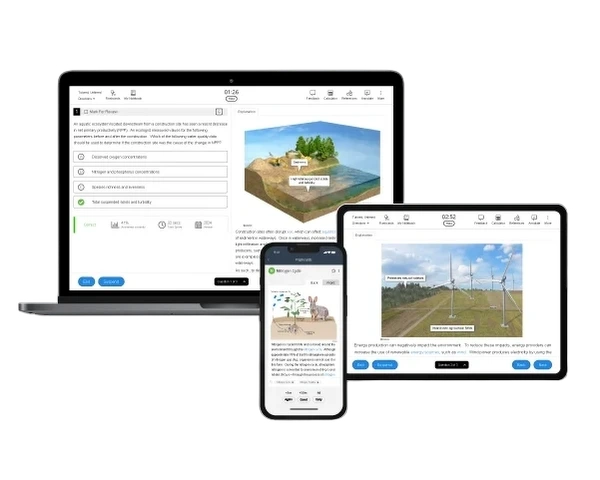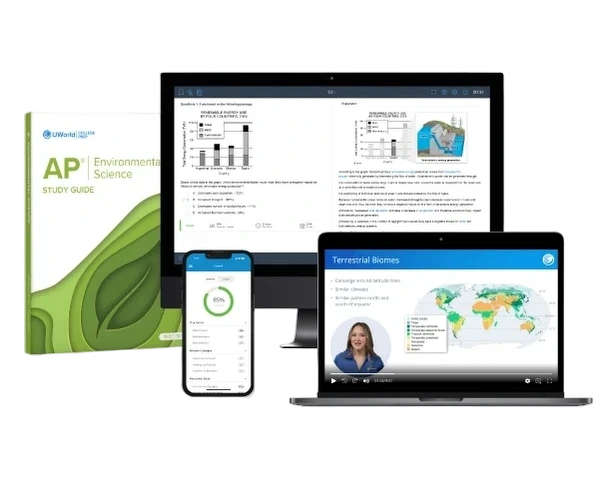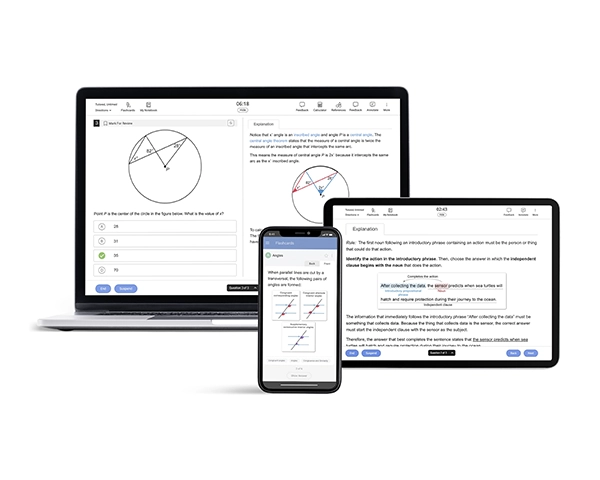AP® Environmental Science (APES) is a comprehensive course that delves into human interactions with the natural world, exploring ecological processes, environmental issues, and sustainability. Preparing for the APES exam is a year-long journey, but breaking it down into manageable steps makes it much more approachable and effective.
How to Prepare for AP Environmental Science
Doing well in APES starts with laying a strong foundation early — by keeping your notes, labs, and assessments to make studying easier and help information stick. But it's not just about staying organized. Engaging with what you've learned by asking questions like “Why does this happen?” or “How does this affect other systems?” helps you connect different topics to see the bigger picture.
Not just that, staying updated with environmental news and learning case studies will help you bring real-world examples into your answers. It may sound overwhelming, but it shouldn't have to be. With a clear, step-by-step strategy, you'll be ready to master the APES exam. So, let's start by understanding the courses covered in the exam.
What Does the APES Course Cover?
College Board® has broken down all the units and skills you'll encounter in the AP Environmental Science Course and Exam Description (CED). These topics will help you understand what you'll learn in class and what you'll be tested on. For a deeper dive, check out our AP Environmental Science CED page for all the details.
The APES comprises of 9 units:
- Unit 1: The Living World: Ecosystems
- Unit 2: The Living World: Biodiversity
- Unit 3: Populations
- Unit 4: Earth Systems and Resources
- Unit 5: Land and Water Use
- Unit 6: Energy Resources and Consumption
- Unit 7: Atmospheric Pollution
- Unit 8: Aquatic and Terrestrial Pollution
- Unit 9: Global Change
How to Score a Perfect 5 on the AP Environmental Science
Now that you're familiar with the exam format and the key topics covered, it's time to focus on mastering the material and refining your approach. Scoring a perfect 5 on the AP Environmental Science exam isn't just about knowing the content — it's about applying smart study techniques and staying consistent throughout your preparation.
Let's walk through proven strategies to help you stay on track, boost your understanding, and give yourself the best chance of passing the APES exam with a perfect score.
It is an active recall technique that helps you strengthen memory retention by forcing you to retrieve information without looking at your notes. Start by reading a topic, close your book and write down everything you remember. Once done, compare your notes with the textbook or study material to identify gaps. It helps reinforce key concepts and improve recall efficiency.
This is a classic mind-mapping visual learning technique to help you organize complex topics by mapping out connections between them. Using either a whiteboard or sticky notes, draw relationships between topics, such as deforestation, climate change, and biodiversity loss. Earring these connections allows you to see the cause-and-effect relationships, making it easier to grasp ecosystem interactions and human environmental impacts.
Explaining concepts to someone else helps solidify your understanding and helps rectify gaps in your grasp of concepts. Choose a study partner or even an imaginary audience and break down environmental science topics into simpler terms. Use real-world examples, analogies, or even diagrams to enhance your comprehension. This technique helps you develop clear and concise explanations, which is essential for free-response questions (FRQs).
Boost your speed and efficiency in answering FRQs and multiple-choice questions (MCQs) under time limits to develop concise responses. Use an approved calculator for the APES exam and refer to the APES formula sheet to see which equations you need to use. This strategy sharpens your time management and improves your overall performance, giving you a better chance of maximizing your APES exam score.
With these techniques, you've built a solid foundation for success on the APES exam. But what matters on the exam day is your approach to MCQs and FRQs. It's about putting your exam-day strategies into practice. Here's what you can do to ace MCQs and FRQs effortlessly.
You'll have 90 minutes to answer 80 MCQs on the APES exam, allowing just over a minute per question. Ensure to focus on key details, use strategies like elimination and keyword spotting, and answer easier questions first. Review the 7 science practices in the CED to strengthen your skills.
For more tips, check out our AP Environmental Science MCQ guide.
You'll have 70 minutes to answer 3 FRQs on the APES exam, giving you about 23 minutes per question. Expect one scientific experiment question, one focused on environmental solutions, and one involving mathematical routines. Keep responses concise and targeted, label each answer clearly, and align your responses with visual stimuli.
For more tips, check out our guide on mastering APES FRQs.
AP Environmental Science Study Material
You can find video lectures on AP Classroom and practice sample FRQs on the College Board website; there are study materials and digital resources you can rely upon to study for the APES exam. Study materials for AP Environmental Sciences come in 2 main types:
-
Study Guides and Digital Learning Tools
Publishers such as UWorld offer top-tier prep books that ensure thorough exam readiness. These resources provide targeted test drills, expert AP Environmental Science exam tips, in-depth topic explanations, and full-length practice exams. UWorld's AP Environmental Science prep course features a detailed study guide and a robust question bank with 400+ multiple-choice questions. Designed to mirror College Board exam standards, it aligns with APES course topics and includes comprehensive explanations and visuals to reinforce key concepts.
- Digital Reference Materials
Additional resources like online essays can greatly enhance AP Environmental Science preparation. The National Geographic Laysan Albatross Virtual Bolus Dissection provides instructional videos and interactive simulations for teachers and students. Additionally, platforms like the Global Footprint Network, TedEd, and Virtual Biology Lab offer valuable insights into APES themes, helping to deepen your understanding of key environmental concepts and real-world applications.

AP Environmental Science Study Plan & Exam Tips
A structured AP Environmental Science study plan is essential for success in the exam. Whether you have 3 months, 1 month, or just 2 weeks to prepare, a well-organized schedule will keep you on track and ensure you cover all the critical topics efficiently. Here are customized study plans for each timeframe to help guide your preparation.
- Begin in February to ensure ample time to cover all units.
- Units 1–2 – The Living World: Spend 2 weeks.
- Units 3–4 – Populations & Earth Systems: Allocate 2 weeks.
- Units 5–6 – Land & Water Use, Energy: Dedicate 2 weeks.
- Units 7–8 – Pollution: Spend 2 weeks.
- Unit 9 – Global Change: Allocate 1 week.
- Final Review & Practice Tests: Dedicate 1 week.
- Refresh your understanding using your textbook or UWorld's AP ES Study Guide.
- Set aside 2 to 3 short sessions each week to review MCQ-style practice questions.
- Consistently revisit challenging concepts.
- Start timing your MCQs to match exam conditions: Aim for 2 minutes per non-calculator question and 3 minutes per calculator question.
- Review past FRQs from the College Board to familiarize yourself with potential essay questions.
- Outline and practice writing responses at least twice a month.
- Time yourself to adapt to the exam pace.
- Create and review flashcards daily for key formulas and rules.
- Regularly schedule breaks to stay refreshed — plan a day off each week or take an afternoon off when necessary.
- Start with a general review of course topics, unit by unit at a quicker pace.
- Utilize resources such as textbooks, class notes, and course materials for concept refreshers.
- Prioritize completing textbook practice problems and using the UWorld's AP Environmental Science Practice Question Bank two to three times per week for 20-30 minutes per study session.
- With UWorld: To save time, focus on explanations for missed questions and reviewing the concepts that need the most improvement.
- Units 1–3 – Ecosystems, Biodiversity & Populations: Spend 1 week.
- Units 4–6 – Earth Systems, Land & Water Use, Energy: Allocate 1 week.
- Units 7–8 – Pollution: Dedicate 1 week.
- Unit 9 – Global Change & Final Review: Spend 3–4 days.
- Practice Tests & Weak Areas Review: Use the remaining days.
- Use any remaining time to review concepts from each unit which you missed previously to reinforce learning.
Kick off your study by tackling a few UWorld AP Environmental Science MCQs in each topic to spot the ones that are harder to you. Dive into the explanations for any questions you miss. If you're still feeling shaky, throw in a video or review your notes on those tough topics. Then, circle back with more UWorld questions to see how much you've improved!
Spend most of your week diving into FRQs—they're a great way to cover lots of topics at once and really efficient for review. Plus, they make you show your work, which helps you get a solid handle on the whole problem-solving process.
When to Start Preparing For APES
Everyone has their own unique learning style, situation, and pace of adaptation — each journey is different. Knowing when to start preparing can make a significant difference in your performance. Whether juggling a packed schedule, just beginning your preparation, retaking the exam, or facing any other circumstance, giving yourself enough time to study effectively for the AP Environmental Science exam is crucial. Here are our expert suggestions tailored to different situations to help you get started:
| Type of Test-Taker | Recommended Timeframe |
|---|---|
| Getting Started: Someone who wants to start preparing with structured resources, build a foundation and confidence from Day 1. |
30-90 days |
| At a Plateau (Stuck): Someone who needs to get “unstuck” by drilling hard questions and fine-tuning to tackle weak areas. |
|
| Retaking the Exam: Someone who has identified mistakes and wants to strategically correct them for success in the next attempt. |
|
| Stressed by the Clock: Someone who wants to get comfortable with time management and avoid common trick answers for peak performance. |
90-180 days |
| Busy: Someone who has a packed schedule and needs a long time to prepare with shorter sessions, ensuring progress. |
180-360 days |
| Struggling with Exam Prep: Someone who wants to strategically overcome pitfalls of MCQs and FRQs and gain confidence for exam success. |
Taking the AP Environmental Science with Confidence
You've done all the hard work and studied for months, but what matters more is how you perform on the exam day. Are you ready mentally, physically, and psychologically to give your best?
Here are some strategies to help you perform at your peak on the exam day:
- Stress Management: Encourage meditation and deep breathing to keep yourself focused and avoid overwhelming yourself by breaking study sessions into manageable chunks.
- Promoting Physical and Mental Well-being: Have quick workout sessions or a yoga session to improve focus, and stay hydrated by drinking enough water to keep your brain sharp.
- Review and Organize: Review key concepts through flashcards or keynotes a day before the exam, organize your exam essentials, and relax.
- On Exam Day: Eat a light, nutritious breakfast, arrive early, and take a few deep breaths to calm yourself. Lastly, keep track of the clock, but don't rush — answer the questions you know first and return to tougher questions later.
Now that you know how to study for AP Environmental Science, it's time to make the most of tools like UWorld College Prep to prepare for AP tests. Dive into the APES exam, use the available resources, and begin your journey toward academic success.

Frequently Asked Questions (FAQs)
Which AP Environmental Science units are the most difficult to learn?
While each unit will have content within it that is difficult to learn, the units that will require more focus due to the complexity of the content include Earth Systems and Resources (U4), Atmospheric Pollution (U7), Aquatic and Terrestrial Pollution (U8), and Global Change (U9).
How do I self-study for AP Environmental Science?
If you plan to self-study for the APES exam, it’s important to give yourself at least 3 months to prepare. You can find resources on College Board or opt for test prep resources such as UWorld.
References
College Board. (2020). AP Environmental Science course and exam description. https://apcentral.collegeboard.org/media/pdf/ap-environmental-science-course-and-exam-description.pdf
College Board. (n.d.). AP Environmental Science: Teacher recommended resources. https://apcentral.collegeboard.org/courses/ap-environmental-science/classroom-resources/teacher-recommended-resources
Read More Related Articles
Not sure how to tackle AP Environmental Science MCQs? Explore proven strategies to sharpen your focus, manage time, and boost your score. Start improving now!
How to Answer AP Environmental Science FRQsWant to ace APES FRQs? Discover strategies for clear, concise answers and proper formatting. Take action now to boost your exam performance!
AP Environmental Science Scoring GuideConfused about AP Environmental Science scoring? Explore this guide to understand the rubric, maximize points, and improve your exam strategy. Start boosting your score today!
Best AP Environmental Science Study GuideLooking for the best AP Environmental Science study guide? Discover top resources, study tips, and strategies to help you master the material. Start your exam prep today!
How to Self-Study for AP Environmental SciencePlanning to self-study for APES? Learn how to create a study schedule, find the best resources, and stay motivated. Take charge of your exam prep now!
Best AP Environmental Science Prep CourseNeed the best APES prep course? Discover expert-led programs, practice tools, and study strategies to help you excel. Begin your preparation now!




